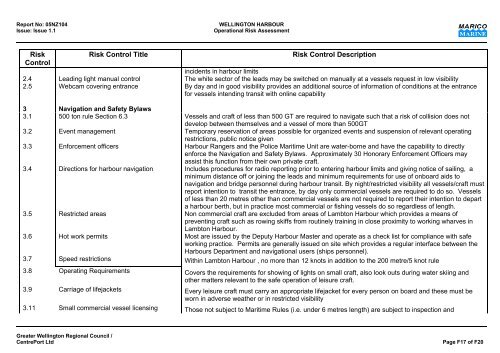MARICO Marine NZ Limited WELLINGTON HARBOUR PORT AND ...
MARICO Marine NZ Limited WELLINGTON HARBOUR PORT AND ...
MARICO Marine NZ Limited WELLINGTON HARBOUR PORT AND ...
Create successful ePaper yourself
Turn your PDF publications into a flip-book with our unique Google optimized e-Paper software.
Report No: 05<strong>NZ</strong>104 <strong>WELLINGTON</strong> <strong>HARBOUR</strong><br />
Issue: Issue 1.1 Operational Risk Assessment<br />
Risk<br />
Control<br />
Risk Control Title Risk Control Description<br />
2.4 Leading light manual control<br />
incidents in harbour limits<br />
The white sector of the leads may be switched on manually at a vessels request in low visibility<br />
2.5 Webcam covering entrance By day and in good visibility provides an additional source of information of conditions at the entrance<br />
for vessels intending transit with online capability<br />
3 Navigation and Safety Bylaws<br />
3.1 500 ton rule Section 6.3 Vessels and craft of less than 500 GT are required to navigate such that a risk of collision does not<br />
develop between themselves and a vessel of more than 500GT<br />
3.2 Event management Temporary reservation of areas possible for organized events and suspension of relevant operating<br />
restrictions, public notice given<br />
3.3 Enforcement officers Harbour Rangers and the Police Maritime Unit are water-borne and have the capability to directly<br />
enforce the Navigation and Safety Bylaws. Approximately 30 Honorary Enforcement Officers may<br />
assist this function from their own private craft.<br />
3.4 Directions for harbour navigation Includes procedures for radio reporting prior to entering harbour limits and giving notice of sailing, a<br />
minimum distance off or joining the leads and minimum requirements for use of onboard aids to<br />
navigation and bridge personnel during harbour transit. By night/restricted visibility all vessels/craft must<br />
report intention to transit the entrance, by day only commercial vessels are required to do so. Vessels<br />
of less than 20 metres other than commercial vessels are not required to report their intention to depart<br />
a harbour berth, but in practice most commercial or fishing vessels do so regardless of length.<br />
3.5 Restricted areas Non commercial craft are excluded from areas of Lambton Harbour which provides a means of<br />
preventing craft such as rowing skiffs from routinely training in close proximity to working wharves in<br />
Lambton Harbour.<br />
3.6 Hot work permits Most are issued by the Deputy Harbour Master and operate as a check list for compliance with safe<br />
working practice. Permits are generally issued on site which provides a regular interface between the<br />
Harbours Department and navigational users (ships personnel).<br />
3.7 Speed restrictions Within Lambton Harbour , no more than 12 knots in addition to the 200 metre/5 knot rule<br />
3.8 Operating Requirements Covers the requirements for showing of lights on small craft, also look outs during water skiing and<br />
other matters relevant to the safe operation of leisure craft.<br />
3.9 Carriage of lifejackets Every leisure craft must carry an appropriate lifejacket for every person on board and these must be<br />
worn in adverse weather or in restricted visibility<br />
3.11 Small commercial vessel licensing Those not subject to Maritime Rules (i.e. under 6 metres length) are subject to inspection and<br />
Greater Wellington Regional Council /<br />
CentrePort Ltd Page F17 of F20
















